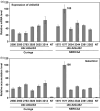Overexpression of an Arabidopsis thaliana galactinol synthase gene improves drought tolerance in transgenic rice and increased grain yield in the field
- PMID: 28378532
- PMCID: PMC5633756
- DOI: 10.1111/pbi.12731
Overexpression of an Arabidopsis thaliana galactinol synthase gene improves drought tolerance in transgenic rice and increased grain yield in the field
Abstract
Drought stress has often caused significant decreases in crop production which could be associated with global warming. Enhancing drought tolerance without a grain yield penalty has been a great challenge in crop improvement. Here, we report the Arabidopsis thaliana galactinol synthase 2 gene (AtGolS2) was able to confer drought tolerance and increase grain yield in two different rice (Oryza sativa) genotypes under dry field conditions. The developed transgenic lines expressing AtGolS2 under the control of the constitutive maize ubiquitin promoter (Ubi:AtGolS2) also had higher levels of galactinol than the non-transgenic control. The increased grain yield of the transgenic rice under drought conditions was related to a higher number of panicles, grain fertility and biomass. Extensive confined field trials using Ubi:AtGolS2 transgenic lines in Curinga, tropical japonica and NERICA4, interspecific hybrid across two different seasons and environments revealed the verified lines have the proven field drought tolerance of the Ubi:AtGolS2 transgenic rice. The amended drought tolerance was associated with higher relative water content of leaves, higher photosynthesis activity, lesser reduction in plant growth and faster recovering ability. Collectively, our results provide strong evidence that AtGolS2 is a useful biotechnological tool to reduce grain yield losses in rice beyond genetic differences under field drought stress.
Keywords: confined field trial; drought; galactinol synthase; grain yield; transgenic rice.
© 2017 The Authors. Plant Biotechnology Journal published by Society for Experimental Biology and The Association of Applied Biologists and John Wiley & Sons Ltd.
Figures







Similar articles
-
Arabidopsis enhanced drought tolerance1/HOMEODOMAIN GLABROUS11 confers drought tolerance in transgenic rice without yield penalty.Plant Physiol. 2013 Jul;162(3):1378-91. doi: 10.1104/pp.113.217596. Epub 2013 Jun 4. Plant Physiol. 2013. PMID: 23735506 Free PMC article.
-
Expression of Arabidopsis glycine-rich RNA-binding protein AtGRP2 or AtGRP7 improves grain yield of rice (Oryza sativa) under drought stress conditions.Plant Sci. 2014 Jan;214:106-12. doi: 10.1016/j.plantsci.2013.10.006. Epub 2013 Oct 20. Plant Sci. 2014. PMID: 24268168
-
Arabidopsis galactinol synthase AtGolS2 improves drought tolerance in the monocot model Brachypodium distachyon.J Plant Physiol. 2014 Aug 15;171(13):1127-31. doi: 10.1016/j.jplph.2014.04.007. Epub 2014 Apr 26. J Plant Physiol. 2014. PMID: 24973584
-
Development of Drought-Tolerant Transgenic Wheat: Achievements and Limitations.Int J Mol Sci. 2019 Jul 8;20(13):3350. doi: 10.3390/ijms20133350. Int J Mol Sci. 2019. PMID: 31288392 Free PMC article. Review.
-
Plant breeding and drought in C3 cereals: what should we breed for?Ann Bot. 2002 Jun;89 Spec No(7):925-40. doi: 10.1093/aob/mcf049. Ann Bot. 2002. PMID: 12102518 Free PMC article. Review.
Cited by
-
Drought tolerance of the grapevine, Vitis champinii cv. Ramsey, is associated with higher photosynthesis and greater transcriptomic responsiveness of abscisic acid biosynthesis and signaling.BMC Plant Biol. 2020 Feb 4;20(1):55. doi: 10.1186/s12870-019-2012-7. BMC Plant Biol. 2020. PMID: 32019503 Free PMC article.
-
Comparative transcriptome analysis reveals significant differences in the regulation of gene expression between hydrogen cyanide- and ethylene-treated Arabidopsis thaliana.BMC Plant Biol. 2019 Mar 4;19(1):92. doi: 10.1186/s12870-019-1690-5. BMC Plant Biol. 2019. PMID: 30832566 Free PMC article.
-
Heterologous Expression of the Transcription Factor EsNAC1 in Arabidopsis Enhances Abiotic Stress Resistance and Retards Growth by Regulating the Expression of Different Target Genes.Front Plant Sci. 2018 Oct 15;9:1495. doi: 10.3389/fpls.2018.01495. eCollection 2018. Front Plant Sci. 2018. PMID: 30374363 Free PMC article.
-
Analysis of Raffinose Synthase Gene Family in Bread Wheat and Identification of Drought Resistance and Salt Tolerance Function of TaRS15-3B.Int J Mol Sci. 2023 Jul 6;24(13):11185. doi: 10.3390/ijms241311185. Int J Mol Sci. 2023. PMID: 37446364 Free PMC article.
-
OsPP65 Negatively Regulates Osmotic and Salt Stress Responses Through Regulating Phytohormone and Raffinose Family Oligosaccharide Metabolic Pathways in Rice.Rice (N Y). 2022 Jul 2;15(1):34. doi: 10.1186/s12284-022-00581-5. Rice (N Y). 2022. PMID: 35779169 Free PMC article.
References
-
- Ahuja, I. , de Vos, R.C. , Bones, A.M. and Hall, R.D. (2010) Plant molecular stress responses face climate change. Trends Plant Sci. 15, 664–674. - PubMed
-
- Babu, R.C. , Zhang, J. , Blum, A. , Ho, T.‐H.D. , Wu, R. and Nguyen, H. (2004) HVA1, a LEA gene from barley confers dehydration tolerance in transgenic rice (Oryza sativa L.) via cell membrane protection. Plant Sci. 166, 855–862.
-
- Bahieldin, A. , Mahfouz, H.T. , Eissa, H.F. , Saleh, O.M. , Ramadan, A.M. , Ahmed, I.A. , Dyer, W.E. et al. (2005) Field evaluation of transgenic wheat plants stably expressing the HVA1 gene for drought tolerance. Physiol. Plantarum, 123, 421–427.
-
- Brandle, J. , McHugh, S. , James, L. , Labbe, H. and Miki, B. (1995) Instability of transgene expression in field grown tobacco carrying the csr1‐1 gene for sulfonylurea herbicide resistance. Nat. Biotechnol. 13, 994–998.
MeSH terms
Substances
LinkOut - more resources
Full Text Sources
Other Literature Sources
Molecular Biology Databases

